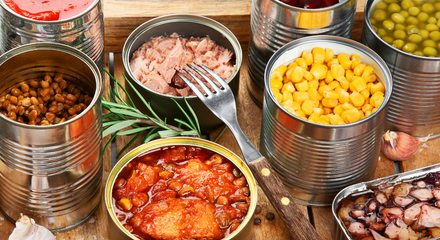Canned foods are cheap and convenient, but many of us trying to eat better and manage our weight find ourselves wondering… are canned foods healthy?
Canned food has gotten somewhat of a bad reputation over the years. It is often marked as an “unhealthy” choice, usually for concerns over sodium levels. However, canned foods can be a quick and easy way to get the nutrition you need on a busy night. You may not know all the different canned food options and what you can get out of them!
What Are Canned Foods?
What exactly makes canned foods what they are? First, foods are harvested from farms. Cans are filled with fruits, vegetables and beans with liquid. They are then sealed and quickly heated. This process kills off any bacteria and makes the food shelf-stable.
Benefits:
- Nutrition: These foods are harvested at their peak to maintain their nutritious qualities. They will have the same level of carbohydrates, fat and protein, as well as most vitamins and minerals. Some vitamins are diminished in the canning process due to the high heat. This affects mostly water-soluble vitamins such as B and C vitamins.
- Long Shelf Life: According to the United States Department of Agriculture (USDA), canned foods can last “indefinitely.” They do have a sell by date listed on them, but this is a suggested date. A rule of thumb often used is to eat your canned foods within two years after their purchase date. With this long shelf life, canned foods can be a staple in your pantry that you use any time.
- Cost-effective: The cost of fresh produce is rising, but canned foods are an inexpensive addition to your pantry.
- Less Waste: How often do you throw away fresh produce that is sitting on your counter or in the crisper of your refrigerator? There is less room for waste with canned foods because they last longer and are easier to eat in smaller portion sizes.
Making the Most of Canned Foods
- Watch what you buy: Not all canned foods are the same. Take a look at the label for those that claim low-sodium, canned in its own juice, or “light” and see if those claims are true.
- Consider rinsing: If you can’t choose low-sodium canned foods, consider rinsing the vegetables you have to reduce their sodium content.
- Avoid damaged cans: If a can is dented or bulged, it may be a sign that it contains bacteria.
What Are Good Options?
There are some handy go-to canned foods that are nice to keep in your pantry to make meal times easier. Try to keep these foods on hand at all times to make easy meals and side dishes when you are in a crunch for time.
- Low-sodium canned vegetables: Need a side for your fresh grilled fish, meatloaf of chicken? Keep these on hand to add to any meal.
- Canned chicken: Make a quick chicken salad, add chicken to soup or use it in a casserole for extra protein. Canned chicken is extremely versatile.
- Beans: This inexpensive protein choice has so many uses! A side of beans works well with soups, salads, stews, chili and vegetable-packed side dishes.
- Light canned fruits: Looking for a sweet dessert? What about a side dish? Canned fruits are also great to add to yogurt, oatmeal and salads.
- Canned chili or stew: Canned stews and soups can make quick and easy protein-packed meals.
- Canned tuna: Tuna is a low-cost protein that is also extremely versatile. Whip up a batch of tuna salad that will cover several lunches.
The bottom line: Canned foods can make excellent, low-cost staples for any diet or eating plan. Just make sure you always read the label to avoid false claims and options that are higher in sodium and sugar. Not all canned foods are created equal.






